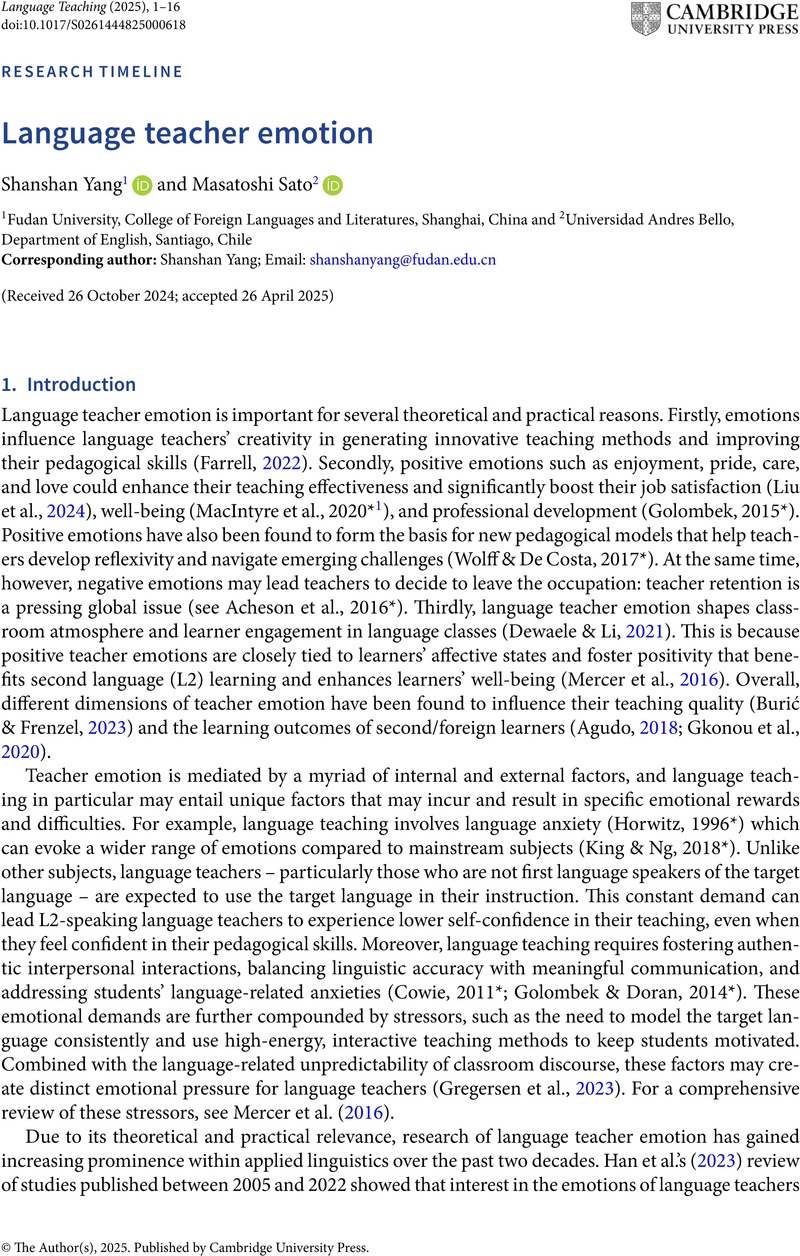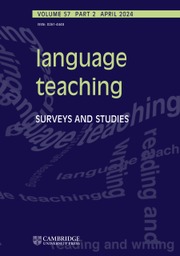No CrossRef data available.
Article contents
Language teacher emotion
Published online by Cambridge University Press: 11 June 2025
Abstract
An abstract is not available for this content so a preview has been provided. Please use the Get access link above for information on how to access this content.

Information
- Type
- Research Timeline
- Information
- Copyright
- © The Author(s), 2025. Published by Cambridge University Press.
Footnotes
*
Indicates full reference appears in the subsequent timeline.
References
Agudo, J. D. D. M. (Ed.). (2018). Emotions in second language teaching: Theory, research and teacher education. Springer.10.1007/978-3-319-75438-3CrossRefGoogle Scholar
Bielak, J., & Mystkowska-Wiertelak, A. (2022). Language teachers’ interpersonal learner-directed emotion-regulation strategies. Language Teaching Research, 26(6), 1082–1105. https://doi.org/10.1177/1362168820912CrossRefGoogle Scholar
Burić, I., & Frenzel, A. C. (2023). Teacher emotions are linked with teaching quality: Cross-sectional and longitudinal evidence from two field studies. Learning and Instruction, 88, 101822. https://doi.org/10.1016/j.learninstruc.2023.101822CrossRefGoogle Scholar
De Costa, P. I., & Nazari, M. (2024). Emotion as pedagogy: Why the emotion labor of L2 educators matters. International Review of Applied Linguistics in Language Teaching. https://doi.org/10.1515/iral-2024-0218CrossRefGoogle Scholar
Dewaele, J. M., & Li, C. (2021). Teacher enthusiasm and students’ social-behavioral learning engagement: The mediating role of student enjoyment and boredom in Chinese EFL classes. Language Teaching Research, 25(6), 922–945. https://doi.org/10.1177/13621688211014538CrossRefGoogle Scholar
Farrell, T. S. (2022). “I felt a sense of panic, disorientation and frustration all at the same time”: The important role of emotions in reflective practice. Reflective Practice, 23(3), 382–393. https://doi.org/10.1080/14623943.2022.2038125CrossRefGoogle Scholar
García-Álvarez, D., Soler, M. J., & Achard-Braga, L. (2021). Psychological well-being in teachers during and post-covid-19: Positive psychology interventions. Frontiers in Psychology, 12, 769363. https://doi.org/10.3389/fpsyg.2021.769363CrossRefGoogle ScholarPubMed
Gkonou, C., Dewaele, J. M., & King, J. (Eds.). (2020). The emotional rollercoaster of language teaching (Vol. 4). Multilingual Matters.Google Scholar
Gregersen, T., Mercer, S., MacIntyre, P., Talbot, K., & Banga, C. A. (2023). Understanding language teacher wellbeing: An ESM study of daily stressors and uplifts. Language Teaching Research, 27(4), 862–883. https://doi.org/10.1177/1362168820965897CrossRefGoogle Scholar
Gross, J. J. (2002). Emotion regulation: Affective, cognitive, and social consequences. Psychophysiology, 39(3), 281–291. https://doi.org/10.1017/S0048577201393198CrossRefGoogle ScholarPubMed
Han, J., Jin, L., & Yin, H. (2023). Mapping the research on language teacher emotion: A systematic literature review. System, 118, 103138. https://doi.org/10.1016/j.system.2023.103138CrossRefGoogle Scholar
Hochschild, A. R. (1983). The managed heart: Commercialization of human feeling. University of California Press.Google Scholar
Lazarus, R. S. (1991). Emotion and adaptation. Oxford University Press.10.1093/oso/9780195069945.001.0001CrossRefGoogle Scholar
Liu, S., Yüce, E., Solhi, M., Şahin, K., & Azari Noughabi, M. (2024). The relationship between language teachers’ enthusiasm and job satisfaction: Investigating the mediating role of foreign language teaching enjoyment. Journal of Multilingual and Multicultural Development, 1–16. https://doi.org/10.1080/01434632.2024.2382886Google Scholar
MacIntyre, P. D., Gregersen, T., & Mercer, S. (2019). Setting an agenda for positive psychology in SLA: Theory, practice, and research. Modern Language Journal, 103(1), 262–274. https://doi.org/10.1111/modl.12544CrossRefGoogle Scholar
MacIntyre, P., & Gregersen, T. (2012). Emotions that facilitate language learning: The positive-broadening power of the imagination. Studies in Second Language Learning and Teaching, 2(2), 193–213. https://doi.org/10.14746/ssllt.2012.2.2.4CrossRefGoogle Scholar
Mercer, S. (2023). The wellbeing of language teachers in the private sector: An ecological perspective. Language Teaching Research, 27(5), 1054–1077. https://doi.org/10.1177/1362168820973510.CrossRefGoogle Scholar
Mercer, S., Oberdorfer, P., & Saleem, M. (2016). Helping language teachers to thrive: Using positive psychology to promote teachers’ professional well-being. In Gabryś-Barker, , & Gałajda, D. (Eds.), Positive psychology perspectives on foreign language learning and teaching (pp. 213–229). Springer. https://doi.org/10.1007/978-3-319-32954-3_12Google Scholar
Morris, S., & King, J. (2024). Language teacher emotions. In Tajeddin, Z., & Farrell, T. S. (Eds.), Handbook of language teacher education, Springer International Handbooks of Education( pp. 1–27). Springer. https://doi.org/10.1007/978-3-031-43208-8_8-1Google Scholar
Swacha, J. (2022). A non-iterative constrained measure of research impact. Information, 13(7), 319. https://doi.org/10.3390/info13070319CrossRefGoogle Scholar
Swain, M. (2013). The inseparability of cognition and emotion in second language learning. Language Teaching, 46(2), 195–207. https://doi.org/10.1017/S0261444811000486CrossRefGoogle Scholar
Taylor, J. (2011). The assessment of research quality in UK universities: Peer review or metrics? British Journal of Management, 22(2), 202–217. https://doi.org/10.1111/j.1467-8551.2010.00722.xCrossRefGoogle Scholar
Zembylas, M. (2005). Teaching with emotion: A postmodern enactment. Information Age Publishing.Google Scholar


